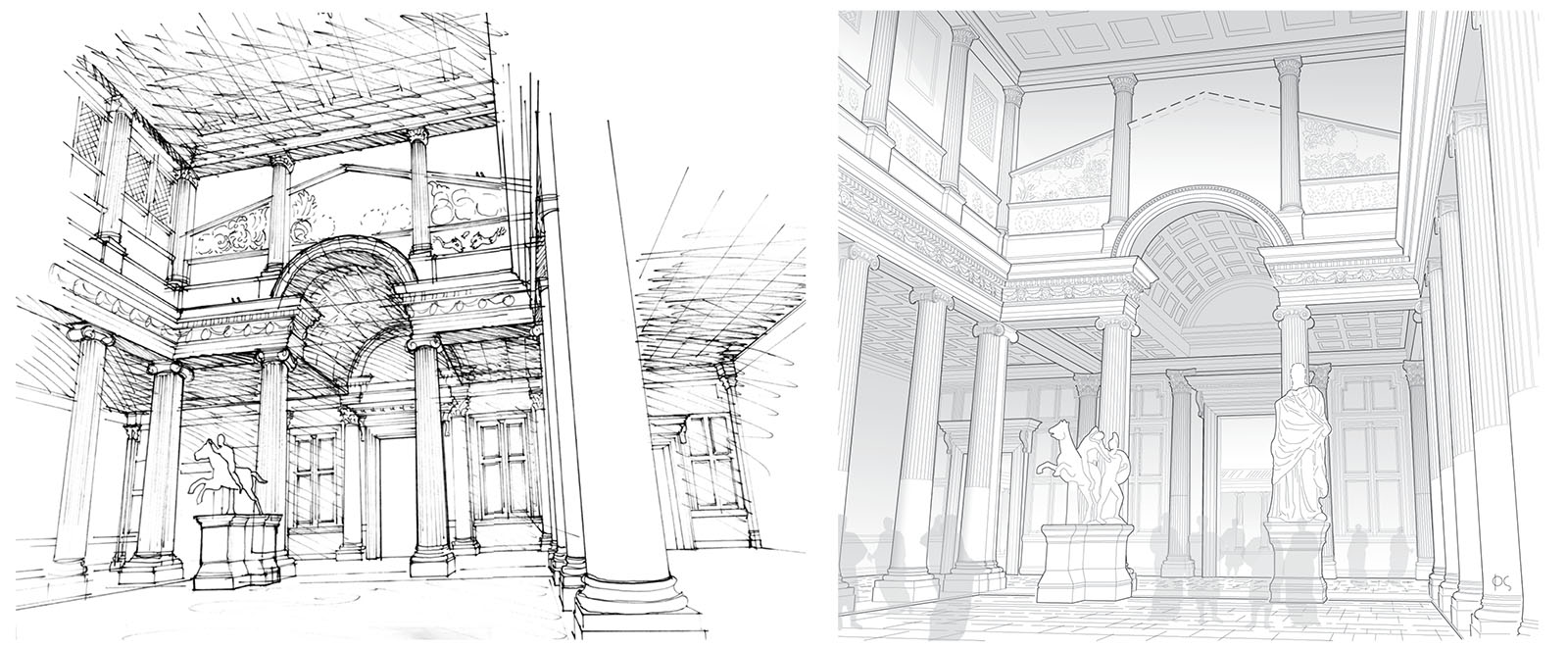Productive encounters between archaeology and architecture
H17:00
Online registration
‚I venerdì pomeriggio‘ series
H17:00
Online registration
‚I venerdì pomeriggio‘ series
I venerdì pomeriggio
I venerdì pomeriggio at Istituto Svizzero are dedicated to our residents. It is an opportunity for the public to learn more about the projects they are working on during this year’s residency.
The event is curated by Ginny Wheeler (Fellow Roma Calling 2020/2021).
Productive encounters between archaeology and architecture
Inspired by the composition of this year’s cohort of fellows at the Istituto Svizzero, this discussion aims to bring together archaeologists, practicing architects, and architectural historians to discuss methodological overlaps between these fields. The goal is to explore how the application of architectural practices and digital tools can impact our research questions as well as our methods of presenting the material in publications. The guiding question for the round table is: to what degree and/or how can modern architectural methods (e.g. sustainable architecture, computational approaches and digital visualization) help us piece together fragmentary evidence relating to ancient spatial experience (including aspects of thermal comfort, sensory experience, and visibility)?
Following a brief introduction, the event will proceed with three 20-minute presentations. Rosa Schiano-Phan will begin by discussing natural cooling strategies in vernacular and pre-modern architecture, as well as methods for the quantification and qualification of the environmental performance of historical sites. Attention will then shift to the Roman world with Phil Stinson, who will speak about drawing by hand and drawing using computer-assisted drawing or 3D modeling with respect to knowledge representation and representation of space. Finally, Kelly McClinton will demonstrate how computational modeling can aid in the process of illustrating and analyzing a decorative program in a Roman house, using the House of Marcus Lucretius in Pompeii as a case study. While the three subjects are certainly diverse, they all connect the past with the future–combining ancient architecture with modern technology–whether as inspiration, or for analysis and presentation.
The presentations are designed to serve as points of departure for the open discussion that will follow. Audience participation is very much encouraged during the second half of the event.
The event will be held in English and it will take place at H17:00 Central European Time (CET).
Please register online to participate.

Program
H17:00 – Adrian Brändli (Istituto Svizzero): Welcome
H17:05 – Ginny Wheeler: Introduction
H17:15 – Rosa Schiano-Phan: Natural Cooling Strategies in Vernacular and Pre-modern Architecture
H17:35 – Phil Stinson: Drawing on the Mind: Spatial Representation for the Architect-Archaeologist
H17:55 – Kelly McClinton: Revitalizing the Roman Garden: The Application of 3D Computational Modeling to the House of Marcus Lucretius in Pompeii
H18:15-19:00 – Open Discussion
Speakers
Ginny Wheeler (University of Bern / Fellow Roma Calling 2020/21)
Ginny Wheeler has a BA from Amherst College in European Studies and an MPhil in Classical Archaeology from the University of Oxford. She is currently a PhD candidate and part of the SNF-funded project Transforming the Past at the University of Bern. While in Rome, she is continuing to work on her dissertation, which focuses on late antique fountains and water displays in the Western Roman Empire (3rd-6th centuries AD).
Find out more about Ginny Wheeler’s project, read her latest contribution on the blog of Istituto Svizzero on the website of the Swiss daily newspaper Le Temps.
Kelly E. McClinton (University of Oxford)
Kelly E. McClinton’s research focuses on Roman art and architecture, the perception of ancient spaces, and the archaeology of Roman houses. She is particularly interested in how ancient material and visual evidence, as well as literary sources, can help us to more fully understand how ancient people actually lived in and experienced the art and architecture around them. She recently completed a doctorate in Digital Humanities on the application of computational methods to the study of domestic Roman art and architecture. At Oxford, Kelly is now working on a DPhil project that considers the aesthetic maintenance of domestic spaces in Late Antique Rome.
Rosa Schiano-Phan (University of Westminster)
Rosa Schiano-Phan is Principal Lecturer in Architecture and Environmental Design and course leader of the Master of Science and PhD programme in Architecture and Environmental Design in the School of Architecture and Cities at the University of Westminster. Prior to completing her PhD at the Architectural Association (London), she worked as an architect and environmental design consultant after studying architecture in Naples. She is also co-director of Natural Cooling Ltd, an environmental design consultancy firm, and co-author of The Architecture of Natural Cooling (2020, 2nd. ed.) and The Architecture and Engineering of Downdraught Cooling (2010). Her research interests include passive cooling, the thermal performance of buildings, and sustainable architecture more broadly.
Philip Stinson (University of Kansas)
Phil Stinson is Associate Professor of Classics at the University of Kansas and Curator-in-Charge of the Wilcox Classical Museum. Phil studied both architecture and architectural history/theory before completing his PhD in History of Art and Classical Archaeology from New York University (2007). His research interests range from the architecture and urbanism of the Greco-Roman world to digital humanities. He is author of Aphrodisias VII. The Civil Basilica (2016).
Vestibule of the Civil Basilica of Aphrodisias (c. 100 CE). Image courtesy of Phil Stinson.